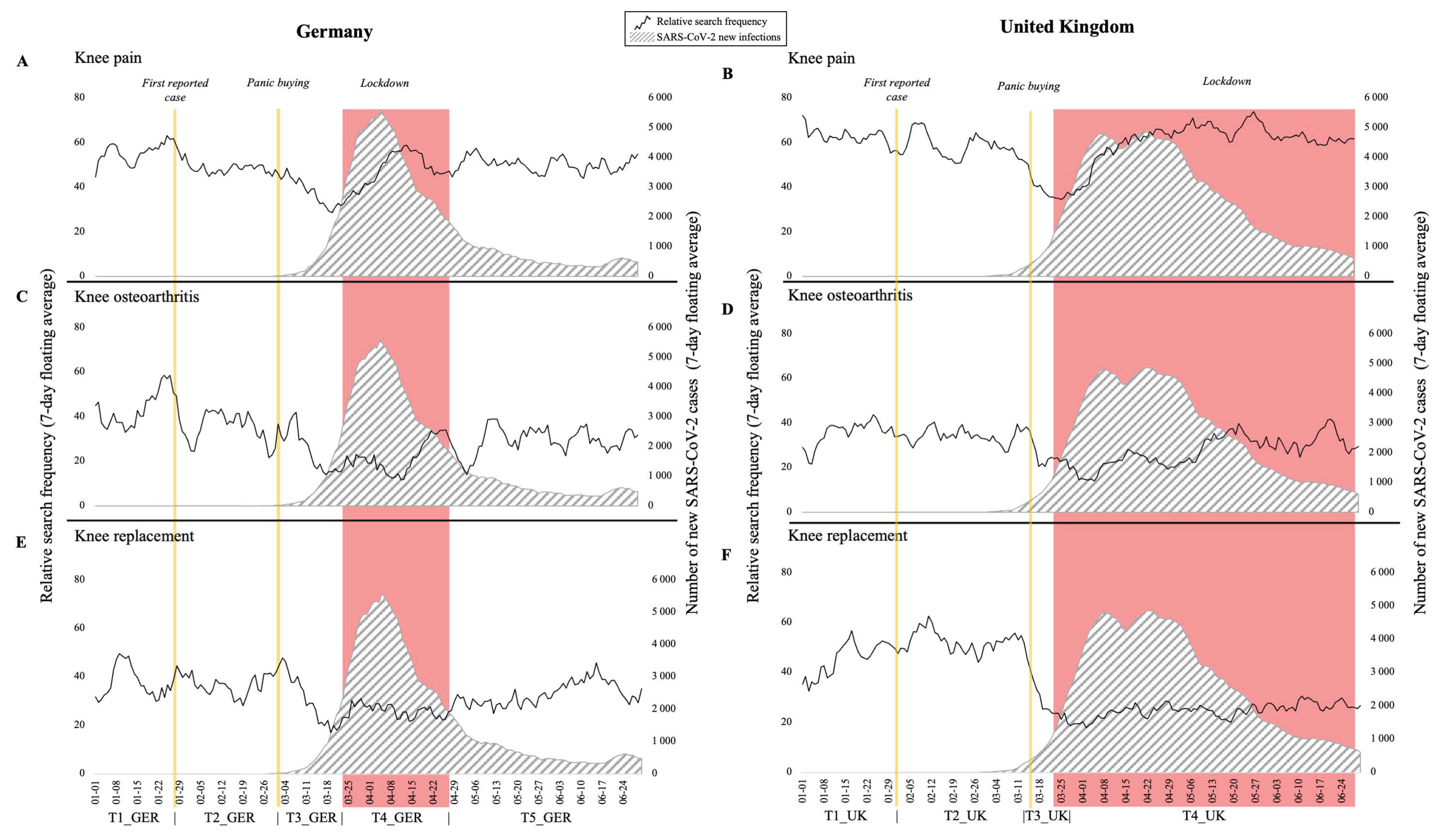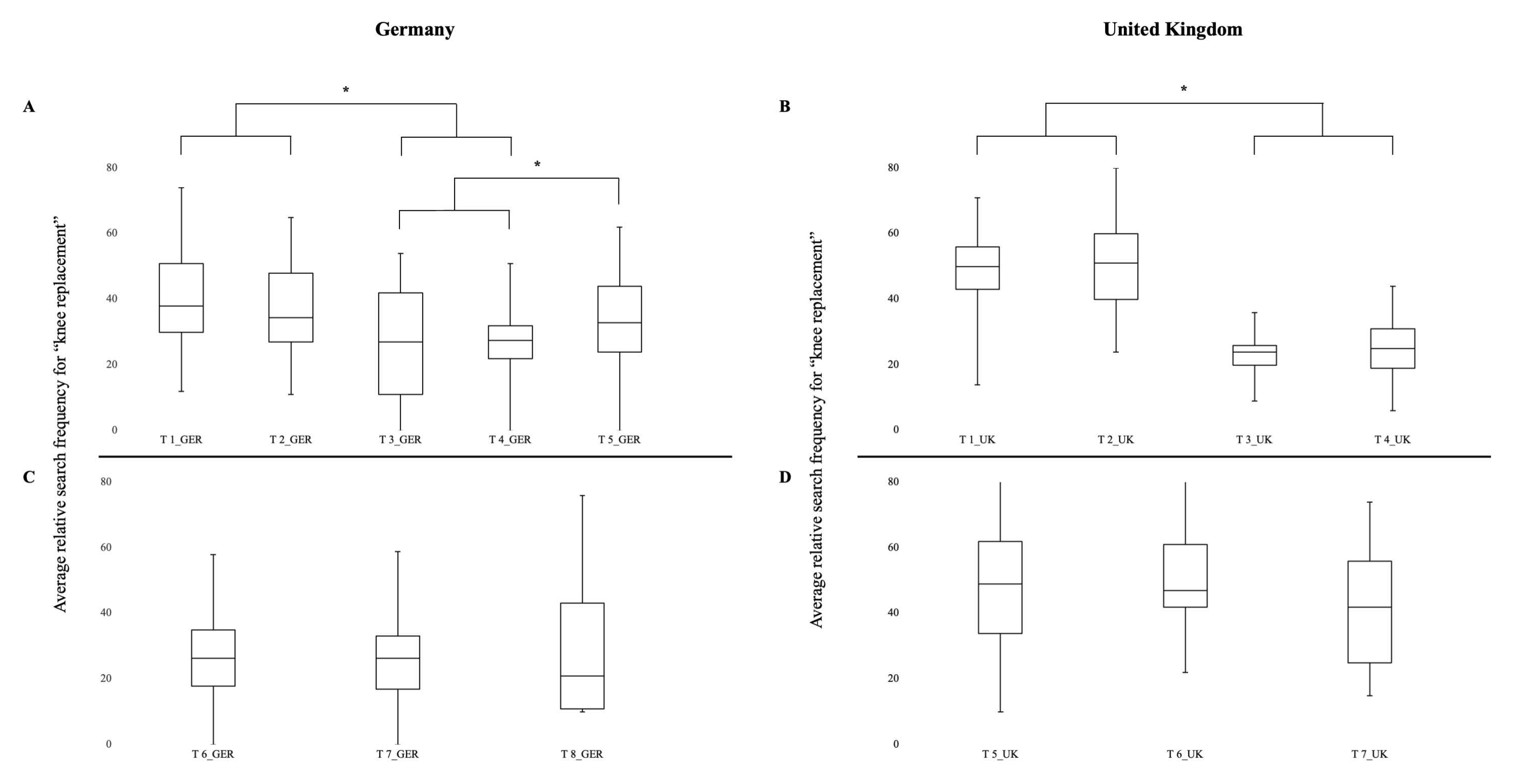Public Interest in Knee Pain and Knee Replacement during the SARS-CoV-2 Pandemic in Western Europe
Abstract
1. Introduction
2. Materials and Methods
2.1. Google Trend Analysis
2.2. SARS-CoV-2 Case Numbers
2.3. Outpatient Department
3. Results
3.1. Public Interest
3.2. Patient Composition in Outpatient Department
4. Discussion
Author Contributions
Funding
Institutional Review Board Statement
Data Availability Statement
Acknowledgments
Conflicts of Interest
References
- Robert Koch Institut. Gesamtübersicht der pro Tag ans RKI übermittelten Fälle, Todesfälle und 7-Tages-Inzidenzen nach Bundesland und Landkreis. 2021. Available online: https://www.rki.de/DE/Content/InfAZ/N/Neuartiges_Coronavirus/Daten/Fallzahlen_Kum_Tab.html (accessed on 5 January 2021).
- Land Berlin. Verordnung zur Eindämmung des Coronavirus in Berlin. Available online: https://www.berlin.de/corona/massnahmen/verordnung/ (accessed on 14 March 2020).
- Osterloh, F. Coronavirus: Krankenhäuser verschieben planbare Eingriffe. Dtsch. Ärzteblatt 2020, 117, 12. [Google Scholar]
- Bialas, E.; Schleppers, A.; Auhuber, T. COVID-19: Auswirkungen des Lockdowns auf die operative Patientenversorgung in Deutschland im April 2020. Anästh Intensivmed 2021, 62, 54–62. [Google Scholar] [CrossRef]
- Land Berlin. Zehnte Verordnung zur Änderung der SARS-CoV-2-Infektionsschutzverordnung. Available online: https://www.berlin.de/corona/_assets/downloads/10-andvo-sars-cov-2-infschv_nach_senat_endfassung.pdf (accessed on 29 October 2020).
- Land Berlin. SARS-CoV-2-Infektionsschutzmaßnahmenverordnung. Available online: https://www.berlin.de/corona/massnahmen/verordnung/artikel.928509.php (accessed on 14 December 2020).
- Prime Minister’s Office; Government of the United Kingdom. Prime Minister’s Statement on Coronavirus (COVID-19): 31 October 2020; 2020. Available online: https://www.gov.uk/government/speeches/prime-ministers-statement-on-coronavirus-covid-19-31-october-2020 (accessed on 3 March 2021).
- Scott, C.E.H.; MacDonald, D.J.; Howie, C.R. ‘Worse than death’ and waiting for a joint arthroplasty. Bone Jt. J. 2019, 101, 941–950. [Google Scholar] [CrossRef] [PubMed]
- Mueller, M.; Boettner, F.; Karczewski, D.; Janz, V.; Felix, S.; Kramer, A.; Wassilew, G.I. Dealing with the COVID-19 pandemic in orthopaedics: Experiences and procedure in Germany. Bone Jt. Open 2020, 1, 309–315. [Google Scholar] [CrossRef] [PubMed]
- Barker, K.; E Lamb, S.; Toye, F.; Jackson, S.; Barrington, S. Association between radiographic joint space narrowing, function, pain and muscle power in severe osteoarthritis of the knee. Clin. Rehabil. 2004, 18, 793–800. [Google Scholar] [CrossRef] [PubMed]
- Perka, C.; Mockel, G.; Boenick, U. Kinetic and kinematic gait analysis before and after total knee endoprosthesis implantation. Z. Orthop. Ihre Grenzgeb. 2000, 138, 191–196. [Google Scholar] [CrossRef] [PubMed]
- Landy, D.C.; Chalmers, B.P.; Utset-Ward, T.J.; Ast, M.P. Public Interest in Knee Replacement Fell During the Onset of the COVID-19 Pandemic: A Google Trends Analysis. HSS J. 2020, 16, 24–28. [Google Scholar] [CrossRef] [PubMed]
- Government of the United Kingdom. The Official UK Government Website for Data and Insights on Coronavirus (COVID-19). 2021. Available online: https://coronavirus.data.gov.uk (accessed on 5 January 2021).
- Ahorsu, D.K.; Lin, C.-Y.; Imani, V.; Saffari, M.; Griffiths, M.D.; Pakpour, A.H. The Fear of COVID-19 Scale: Development and Initial Validation. Int. J. Ment. Health Addict. 2020, 1–9. [Google Scholar] [CrossRef] [PubMed]
- He, W.; Kienzle, A.; Liu, X.; Müller, W.E.G.; Feng, Q. In vitro 30 nm silver nanoparticles promote chondrogenesis of human mesenchymal stem cells. RSC Adv. 2015, 5, 49809–49818. [Google Scholar] [CrossRef]
- Ginsberg, J.; Mohebbi, M.H.; Patel, R.S.; Brammer, L.; Smolinski, M.S.; Brilliant, L. Detecting influenza epidemics using search engine query data. Nature 2009, 457, 1012–1014. [Google Scholar] [CrossRef] [PubMed]
- Guo, P.; Zhang, J.; Wang, L.; Yang, S.; Luo, G.; Deng, C.; Wen, Y.; Zhang, Q. Monitoring seasonal influenza epidemics by using internet search data with an ensemble penalized regression model. Sci. Rep. 2017, 7, 46469. [Google Scholar] [CrossRef] [PubMed]
- Park, C.N.; White, P.B.; Meftah, M.; Ranawat, A.S.; Ranawat, C.S. Diagnostic Algorithm for Residual Pain After Total Knee Arthroplasty. Orthopedics 2016, 39, e246–e252. [Google Scholar] [CrossRef] [PubMed]
- Kienzle, A.; Walter, S.; Von Roth, P.; Fuchs, M.; Winkler, T.; Müller, M. High Rates of Aseptic Loosening After Revision Total Knee Arthroplasty for Periprosthetic Joint Infection. JBJS Open Access 2020, 5, e20.00026. [Google Scholar] [CrossRef] [PubMed]
- Alexandra, F.; DeJong, M.; Fish, P.N.; Hertel, J. Running behaviors, motivations, and injury risk during the COVID-19 pandemic: A survey of 1147 international runners. PLoS ONE 2021, 16, e0246300. [Google Scholar]
- Frühauf, A.; Schnitzer, M.; Schobersberger, W.; Weiss, G.; Kopp, M. Jogging, nordic walking and going for a walk-interdisciplinary recommendations to keep people physically active in times of the covid-19 lockdown in Tyrol, Austria. Curr. Issues Sport Sci. (CISS) 2020. [Google Scholar] [CrossRef][Green Version]
- Busemeyer, M.R. Heilmittel oder Zankapfel?: Vertrauen in das Gesundheitssystem während der Corona-Krise. 2020. Available online: http://nbn-resolving.de/urn:nbn:de:bsz:352-2-1w4zicgj8bcrz4 (accessed on 3 March 2021).
- Enste, D.; Suling, L. Vertrauen in Wirtschaft, Staat, Gesellschaft 2020: Vertrauensindex: Europäische Länder im Vergleich. IW Policy Paper. 2020. Available online: https://www.iwkoeln.de/studien/iw-policy-papers/beitrag/dominik-h-enste-lena-suling-vertrauen-in-wirtschaft-staat-gesellschaft-2020.html (accessed on 3 March 2021).
- Brown, T.S.; Bedard, N.A.; Rojas, E.O.; Anthony, C.A.; Schwarzkopf, R.; Barnes, C.L.; Stambough, J.B.; Mears, S.C.; Edwards, P.K.; Nandi, S.; et al. The Effect of the COVID-19 Pandemic on Electively Scheduled Hip and Knee Arthroplasty Patients in the United States. J. Arthroplast. 2020, 35, S49–S55. [Google Scholar] [CrossRef] [PubMed]
- Nationalen Akademie der Wissenschaften Leopoldina. Coronavirus-Pandemie: Die Feiertage und den Jahreswechsel für Einen Harten Lockdown Nutzen. 7. Ad-hoc-Stellungnahme zur Coronavirus-Pandemie. 2020. Available online: https://www.leopoldina.org/publikationen/detailansicht/publication/coronavirus-pandemie-die-feiertage-und-den-jahreswechsel-fuer-einen-harten-lockdown-nutzen-2020/ (accessed on 3 March 2021).
- Parvizi, J.; Gehrke, T.; Krueger, C.A.; Chisari, E.; Citak, M.; Van Onsem, S.; Walter, W.L.; the International Consensus Group (ICM) and Research Committee of the American Association of Hip and Knee Surgeons (AAHKS). Resuming Elective Orthopaedic Surgery During the COVID-19 Pandemic: Guidelines Developed by the International Consensus Group (ICM). J. Bone Jt. Surg. Am. 2020, 102, 1205–1212. [Google Scholar] [CrossRef] [PubMed]
- Saxena, A.; Bullock, M.; Danoff, J.R.; Rodd, D.S.; Fischer, S.J.; Stronach, B.M.; Levine, B.R. Educating Surgeons to Educate Patients About the COVID-19 Pandemic. J. Arthroplast. 2020, 35, S65–S67. [Google Scholar] [CrossRef] [PubMed]




Publisher’s Note: MDPI stays neutral with regard to jurisdictional claims in published maps and institutional affiliations. |
© 2021 by the authors. Licensee MDPI, Basel, Switzerland. This article is an open access article distributed under the terms and conditions of the Creative Commons Attribution (CC BY) license (http://creativecommons.org/licenses/by/4.0/).
Share and Cite
Kienzle, A.; Biedermann, L.; Babeyko, E.; Kirschbaum, S.; Duda, G.; Perka, C.; Gwinner, C. Public Interest in Knee Pain and Knee Replacement during the SARS-CoV-2 Pandemic in Western Europe. J. Clin. Med. 2021, 10, 1067. https://doi.org/10.3390/jcm10051067
Kienzle A, Biedermann L, Babeyko E, Kirschbaum S, Duda G, Perka C, Gwinner C. Public Interest in Knee Pain and Knee Replacement during the SARS-CoV-2 Pandemic in Western Europe. Journal of Clinical Medicine. 2021; 10(5):1067. https://doi.org/10.3390/jcm10051067
Chicago/Turabian StyleKienzle, Arne, Lara Biedermann, Evgeniya Babeyko, Stephanie Kirschbaum, Georg Duda, Carsten Perka, and Clemens Gwinner. 2021. "Public Interest in Knee Pain and Knee Replacement during the SARS-CoV-2 Pandemic in Western Europe" Journal of Clinical Medicine 10, no. 5: 1067. https://doi.org/10.3390/jcm10051067
APA StyleKienzle, A., Biedermann, L., Babeyko, E., Kirschbaum, S., Duda, G., Perka, C., & Gwinner, C. (2021). Public Interest in Knee Pain and Knee Replacement during the SARS-CoV-2 Pandemic in Western Europe. Journal of Clinical Medicine, 10(5), 1067. https://doi.org/10.3390/jcm10051067






